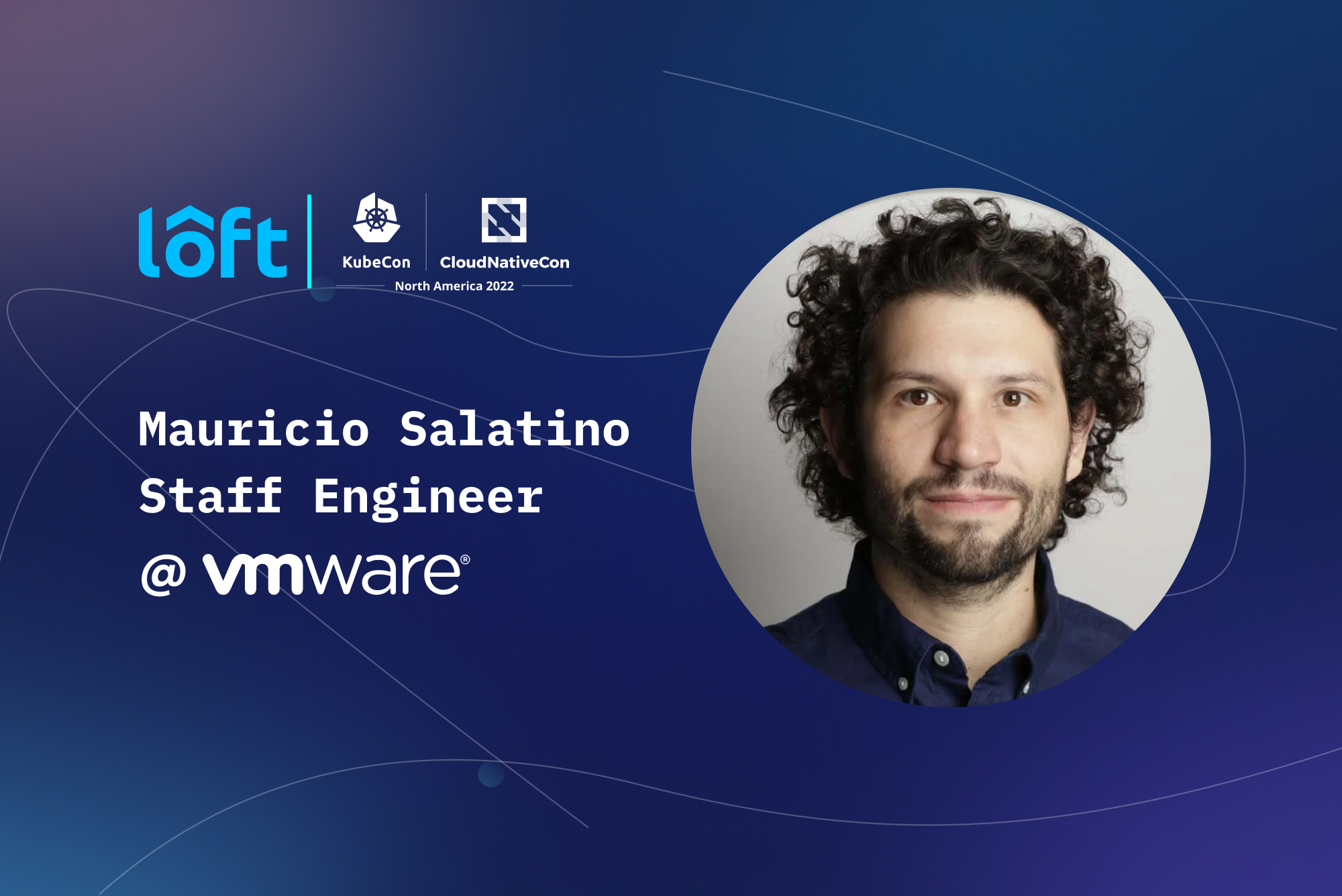Loft Labs is excited to welcome Kubecon North America 2022 keynote speaker Mauricio “Salaboy” Salatino for an exclusive interview where we dive into the struggles facing platform engineers with the CNCF ecosystem. Mauricio and his co-speaker Whitney Lee will be presenting a demo for their keynote presentation focused on the provisioning of virtual clusters with Crossplane, vcluster, and Knative, to develop an internal development platform.
Rich: How did you learn about vcluster?
Mauricio: I had heard about vcluster in the context of multi-tenancy. While delivering training for LearnK8s and working for different companies, I’ve repeatedly seen teams struggling to answer a very simple question: One cluster or multiple clusters? I’ve seen teams starting simple with namespaces inside a single Kubernetes Cluster and then struggling to move to use multiple clusters when the isolation levels of namespaces are not enough. And that is precisely where I see vcluster as a better alternative because it provides, from the get-go, the separation into different Kubernetes API Servers. In today’s world, where every organization is building its internal development platform, I see tools like vcluster as critical components of these platforms.
Rich: In the demo for your KubeCon keynote you provisioned virtual clusters with vcluster and Crossplane. Can you explain how that works? And what’s your experience been like using those two tools together?
Mauricio: The demo presented at the KubeCon keynote session uses Crossplane, vcluster, and Knative, all working together around this concept of building internal development platforms. Crossplane is used to abstract where cloud resources are created. With Crossplane, we can declaratively create Kubernetes clusters in all major cloud providers, but creating these clusters is expensive, and it is a process that takes time. This is where using vcluster can save you time and money. Because, to my surprise, creating a vcluster is just installing a Helm chart into your existing cluster. We can use the Crossplane Helm Provider to create vcluster from inside a Crossplane Composition, and that is exactly what my demo is doing. But vcluster doesn’t stop there, because with vcluster Plugins you can share tools between the host cluster and the virtual clusters. The demo shows how you can enable your vclusters with tools like Knative Serving (for dynamic autoscaling and advanced traffic management) without installing Knative Serving in each cluster. In a scenario where you have 10 teams all working in different vclusters and using tools like Knative Serving you save on installing and running 9 Knative Serving installations.
Rich: Your demo focused on provisioning environments for developers. What do you think makes vcluster a great tool for dev environments?
Mauricio: vclusters are better than namespaces because they provide more isolation and are cheaper than fully fledged clusters. Suppose you have developers working with cluster-wide resources such as CRDs and tools that need to be installed to do their work. In that case, vclusters will give them the freedom to work against a dedicated Kubernetes API Server, where they will have total freedom to do what they need. By using vcluster you can give your development teams full access to their dedicated API servers without the need of creating, maintaining and paying for full-fledged Kubernetes Control Planes.
Rich: There are so many new tools in the Kubernetes space and more arriving all the time. The CNCF landscape continues to grow. What do you look for when you evaluate new open source, cloud native tools?
Mauricio: I evaluate their (project) community, and in the last two years, I’ve been very interested in tools that fit into the story of building internal developer platforms, as I’ve been in that space for a long time. Most of my work in the open source space is around helping developers to be more productive in building their software.
If you are evaluating Open Source / CNCF projects, check their maturity level, who (which company or companies) are sponsoring the project, and how healthy their community is. Looking at which companies are active in their community forums or slack channels is a great validation to see if other companies in your industry are trying to solve the same problems that you are facing.
Rich: There’s been a lot of focus on the role of platform engineer the last few years. What do you think are the big challenges facing platform engineers today?
Mauricio: I’ve been writing about these topics lately in my blog, you can read more about this here -> The challenges of building platforms on top of Kubernetes Part 1, Part 2, Part 3, Part 4
But the big challenge nowadays is to keep up with all that is happening in the Cloud Native space, so you need to look for tools that:
- Be ready to pivot: look for tools that provide you with the right abstractions to be able to pivot if things change, Crossplane is a big player in this space, but there are other projects that are worth looking at. If you are really into platform building you should check a project that I am hoping gets donated to the CNCF called Kratix. These folks are working on providing the right abstractions to build platforms allowing platform teams to focus on deciding which projects they want to use and how those projects will work together.
- Reuse instead of build: try to identify the problem that you are trying to solve into two different buckets: 1) Generic problem that every company will have 2) very specific challenge that is specific to your company. If you are looking for tools to solve problems in the first bucket, then make sure that you don’t build an in-house solution. If you are looking for tools to solve problems in the second bucket you need to focus your search on a combination of an existing tools can do the work to make sure that you don’t spend time and effort reinventing the wheel just because the tools available doesn’t match 100% your requirements.
- Ecosystem integrations: When you look at a specific tool make sure that it integrates well with the other tools in the ecosystem. Don’t be tricked by the fact that they are all Kubernetes projects. Depending on how you want tools to work together your platform team might need to spend a considerable amount of time to make these tools work for your specific use case.
- Tailored Developer Experiences are the best way to promote your platform: you need to spend a lot of time and effort into building amazing developer experiences for your teams to have the right tools to do their work. These developer experiences are enabled by the tools that the platform team chooses to use and by always keep improving how application development teams interact with the platform.
If you are into building platforms, I am currently writing a book titled ”Continuous Delivery for Kubernetes” where I cover tools like Tekton, Crossplane, vcluster, Keptn, Knative, ArgoCD, Helm, among others, to build platforms that are focused on delivering more software more efficiently.
Rich: Thanks for your time Mauricio.
If you want to learn more about vcluster, check our vcluster.com for links to the docs, the GitHub repo, and our community Slack. You can find Mauricio on Twitter at @salaboy, and Rich at @richburroughs.
Deploy your first virtual cluster today.

